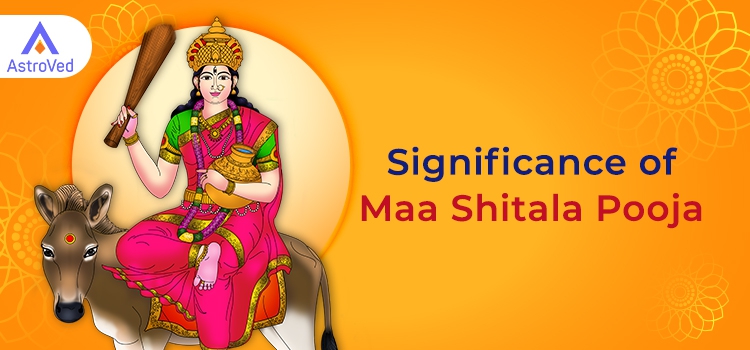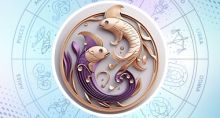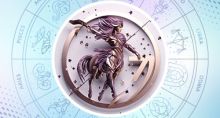Significance of Maa Shitala Pooja
Sheetala/Shitala is a Sanskrit word that means '"coolness." It is also the name of a Hindu goddess who Hindus worship, mostly in North India. She is an incarnation of Goddess Parvati. People worship her for cures from sores, poxes (especially smallpox), ghouls, pustules, and diseases. Devotees usually worship her on Tuesdays, on Saptami and Ashtami (the 7th and 8th day of a Hindu month), especially after Holi during Chaitra month (April-May). This is referred to as Sheetala Saptami and Sheetala Ashtami, respectively.
Maa Shitala is mostly a women’s Goddess. She is like a mother who protects her children (devotees) from illness. She is also a fertility Goddess who can bestow good husbands and healthy sons. Her blessings can ensure the welfare of the family. She also protects one’s sources of livelihood. People also worship Shitala for rainfall and for preventing famines, droughts, cattle diseases, etc.

The Goddess has many honorific titles, like Thakurani, Jagrani (queen of the world), Karunamayi (she who is full of mercy), Mangala (the auspicious one), Bhagavati (the Goddess), Dayamayi (she who is compassionate and kind), etc.
In Gurgaon, Haryana, she is Kripi (Drona’s wife) and has a temple dedicated to her, the Sheetala Mata Mandir Gurgaon. In South India, it is Mariamman, the Goddess incarnate, who takes on her functions. She is a Dravidian goddess.
Shitala is a tribal deity. She wears red clothes, and her mount is a donkey. In her four arms, she holds a silver broom, a winnowing fan, a bowl, and an urn with Gangajal. She protects her devotees from plagues and deadly diseases. Hindu mythology says that Goddess Katyayani, who is an incarnation of Shakti, manifested as Shitala to kill the deadly demon Jwarasur (‘Jwara’ means ‘fever’), who threatened to inflict deadly fever and plague on the world. The Puranas have many references to her greatness.
Shitala Pooja Ritual
Only women perform the Shitala Pooja (but men can also take part in the ceremony). She is usually worshipped in the dry seasons of winter and spring on Sheetala Saptami. There are many arti sangrah and stutis for Shital Pooja, like Shri Shitla Mata Chalisa, Shitala Maa ki arti, and Shri Shitala Mata ashtak.
Most families do not light their stoves on the day of Ashtami/Saptami. They eat cold food, which they cook the day before, and consume it as Prasad. The reason is that the festival occurs during the time when spring makes way for summer. Cold food does not aggravate the stomach and has a calming effect. It is also easy to digest. Many people also observe a vrat on this day.
Sheetala Saptami is on the 7th day of the Hindu month Chaitra. On this day, devotees perform Pooja for her after taking a bath in cold water. Devotees perform Shodashopachar Pooja as part of her worship. They offer cooked food and ghee to the Goddess. Women read or listen to the Sheetala Devi Vrat Katha and perform Aarti. They offer raw flour and molasses as prasadam. On this day, they have a cold meal which is cooked the day before i.e. the sixth day. This day is dedicated to cooking and is called Randhan Chhath.
Legend of Goddess Shitala
The Puranas claim that it was Brahma who created Goddess Shitala. He promised her that she would be worshipped as a Goddess on earth, but she had to carry lentil seeds along with her. She said that she needed a companion. Shiva blessed her and used his sweat to create Jwara Asura. Shitala and Jwarasura resided in Devaloka and used a donkey to carry the lentils to whichever place they went. One day, the lentil seeds became smallpox germs and began to spread the deadly disease in Devaloka. After a while, fed up with the disease, the Devas or gods asked her to go to earth and settle down there. There, she would be worshipped by humans.
So Shitala and Jwarasura descended to earth and began searching for a place to stay. King Birat, who was an ardent Shiva devotee, agreed to worship Shitala and gave the couple a place to reside. But an angry Shitala wanted to be worshipped as the supreme deity. Stung by Birat’s refusal, she began to spread different kinds of fevers in the kingdom. Finally, the King agreed to her demands, and people were cured of the disease and all its ill effects.
Slokas and Mantra:
Sheetle har me paap, putra putra sukhprade
Dhandhanya prade devi, pujagruhan namostute
Significance of Shitala Pooja
Maa Shitala’s Pooja has the power to bestow good health and prevent diseases. She protects her devotees from deadly diseases. She can cure diseases like smallpox, chickenpox, measles, skin diseases, etc. By worshipping her, one can gain good health and a long and prosperous life for oneself and one’s family.
Iconography
In North Indian iconography, the Goddess is often depicted along with Jvarasura as her eternal servant. Ghentu-debata, the god of skin diseases, Raktabati, the Goddess of blood infections and the sixty-four epidemics, and Oladevi, another disease goddess (probably cholera), are other deities who are worshipped alongside her.
Sometimes, she is depicted in an eight-handed form, holding items like a trident, broom, discus (cakra), a jar of abrasia, or a pot full of water, branches of neem, Scimitar, conch, and Varada mudra.




















